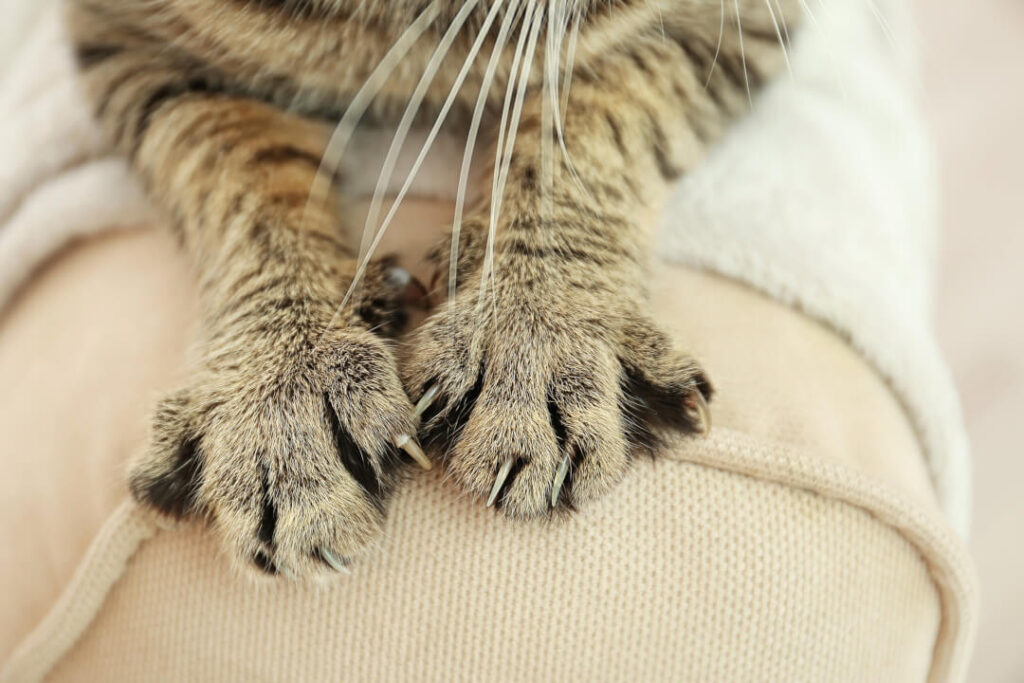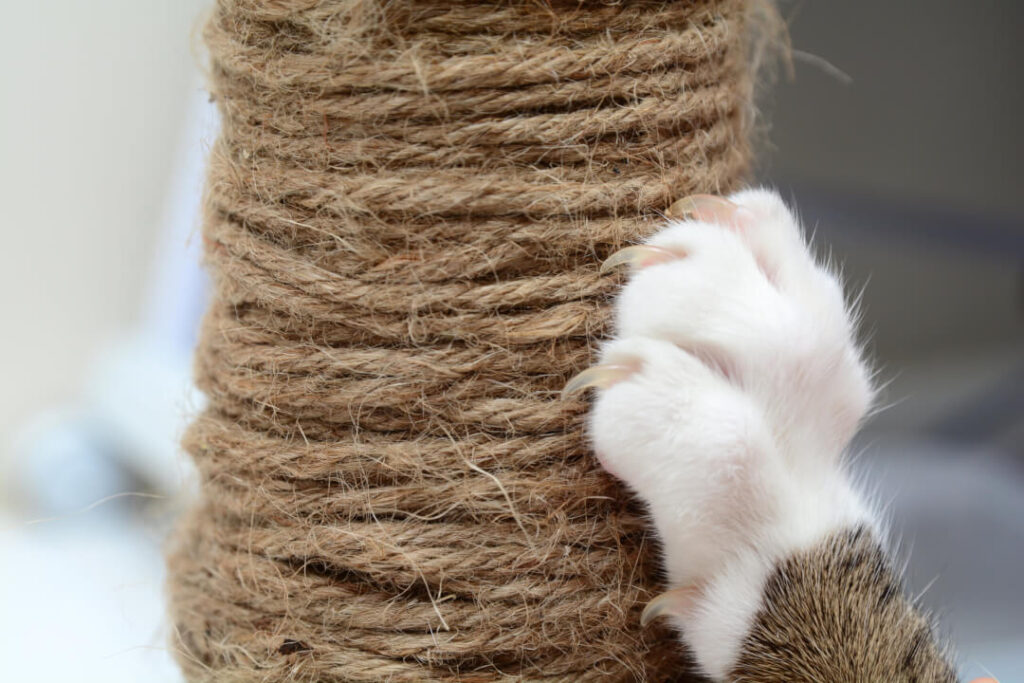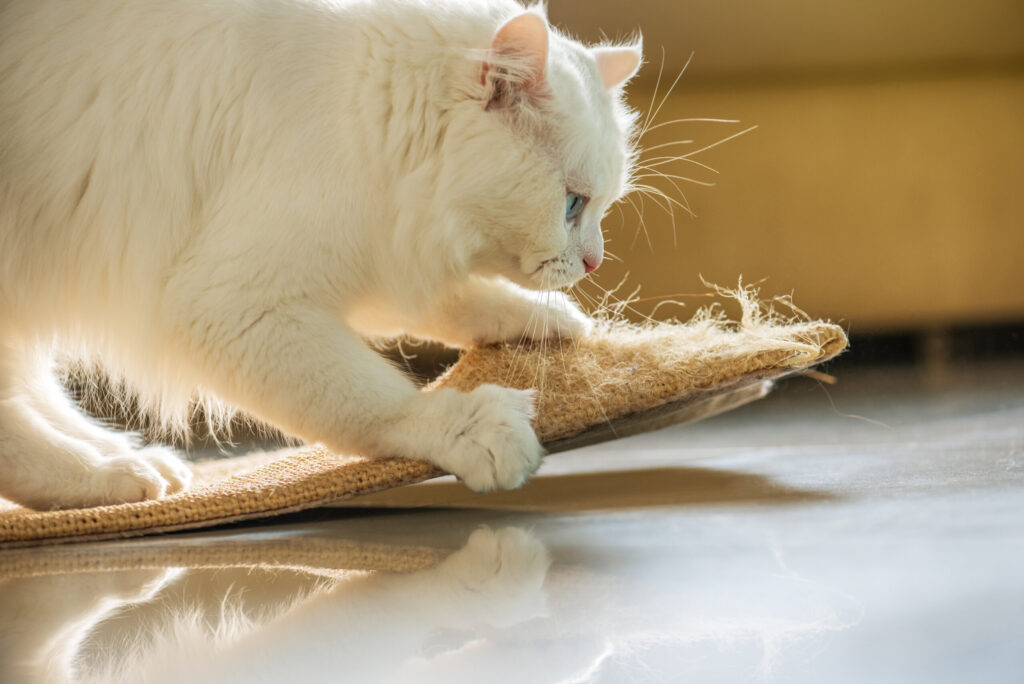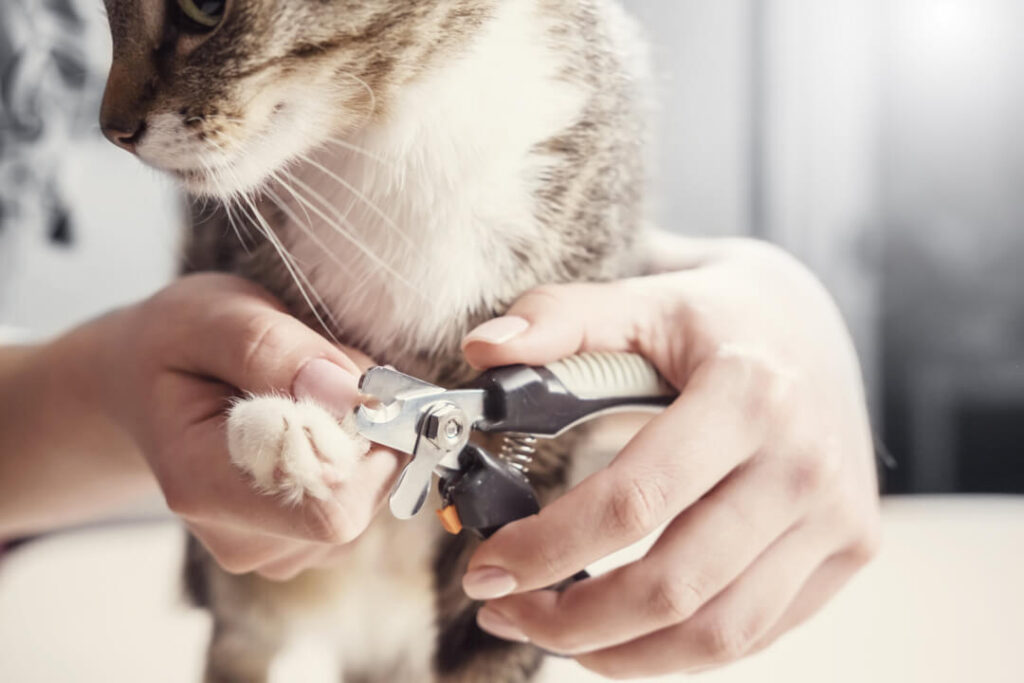‘Velvety paws’ you bet – the little darlings can be quite destructive! People with cats realise eventually – after their favourite arm chair has been shredded – that cats organise ‘their home’ quite systematically themselves. So if you want to keep a “Bonsai Tiger” in your living room, you must be prepared to face some quite new challenges.
If you were just planning to install some designer furniture and redo the wallpaper… you’d better wait a while until you’re single again, because sofas, wooden furniture and wallpaper are top of the cat scratching hit list.
But what is the real reason for this?
Why are cats always scratching all over the place? And is there anything we can do to stop them?
Why do cats scratch?
Scratching as a defence
The claws, a cat’s most important ‘tools’, so to say. Without effectively functioning claws, cats cannot catch their prey. They need claws to catch and hold onto the prey, as well as for climbing and jumping. A cat with blunt claws would be unable to defend itself, and in battles for territory would have no chance against other members of the species.
Cats are loners, and are always concerned to protect their territory. Their patch is important, because it is the source of their food. This is why cats will defend their own patch – if need be, with all the physical resources at their disposal! Failing to hold your own and losing the fight will mean having to go in search of a new territory.
Tom cats who have not been castrated are more aggressive in this respect than castrated toms or female cats. There’s a lot of show involved here – rather like in wrestling – the aim, basically, is to intimidate or impress the opponent, without seriously injuring him. When a new cat intrudes on the territory, or tom kittens turn into cats, it often leads to serious confrontations which are designed to establish the pecking order. Once this has been settled, there is usually no need to go on fighting.
Scratching as a game
Play is fun, and it is important for cats. It is a way of exercising physically and acquiring social skills; cats learn the movement repertoire that they need in order to be successful hunters; and they are also taught manners – in learning that signals have to be unmistakable, to be understood by other members of the species. The exaggeration involved in playing sends a clear signal to any cat: ‘Hey, it’s a game – got it?’ – and will be understood by the other cat as such.
But why do cats sometimes get carried away so that they go too far?
Young cats in particular are sometimes so out of control that they scratch and bite: in the heat of battle they will latch onto something with their front paws and scratch it liberally.
When they are dealing with other feline friends, this is all perfectly OK – they can get the measure of what is going on, and launch a counterattack if appropriate – but humans are generally less charmed by this kind of approach and may even see it as an act of hostility.
Scratching out of boredom
Cats are used to living with us, and have adapted perfectly to us and our way of life over the centuries. But we should never forget that they are still animals with their own intrinsic and natural instincts, which call to be lived out, and indeed need to be!
In common with their ‘wild’ and undomesticated ancestors, all cats have the hunting instinct. It comes out differently in different breeds. Persian cats are rather placid creatures, whereas Burmese, Abyssinian and Siamese cats are more active.
Indoor cats are particularly dependent on daily play sessions and sufficient entertainment. This is at least as important as appropriate food and hygiene. They want to catch something resembling prey – just like their fellows who can go after their hunting instinct feely in the great outdoors.
So if a cat is the only feline in the household and has no companion to tussle with, human bodily parts or pieces of furniture may have to bear the brunt.
Why cats scratch doors, sofas and furniture
Not enough scratching points
We’ve taken everything away from our cats – they don’t have to hunt any more to get food; we make sure that they have a hygienic litter tray to do their business; and we even seek out other felines for them, so they will have someone to play with.

But their instincts are still present in force. We can’t switch them off, and actually of course we wouldn’t want to. In fact that is just the thrill of it, that a ‘wild animal’ like this allows itself to be tamed and shares affection with us.
Catching prey, fighting, chasing games – the fun of movement – but this is the engine that not only keeps the cat physically fit, it also gives the cat challenges and zest for life. Surplus tension that builds up in the body must work itself off – but what if this is impossible? Then the cat will look for a valve. And as few living rooms have trees growing in them these days, the cat will look for any alternative that can be found in a given domestic setting.
Scratching as territorial marking
In the wild, cats scratch trees in order to indicate their presence to other cats and send the message that this is ‘my territory’, by leaving scratches in the bark along with their personal scent.
They also mark their patch with urine and faeces. Scratching trees is a way of delimiting the boundaries: thus far and no further! But another kind of marking is when cats rub their heads on objects or on their humans. If a cat rubs a person’s legs as a greeting, it exchanges scents with its human, creating a sense of togetherness and a certain proprietorial claim.
When it is a matter of marking the territory, otherwise trees are the principal object: the rough bark offers enough resistance, and so is the ideal carrier for the scent; at the same time the claws are maintained and sharpened, as the worn down horny tissue – the empty claw husks – will be simply scraped off on the bark and jettisoned. In fact, cats use trees as a kind of an oversized nail file!
Scratching as personal care
All cats see extensive personal care as massively important. After all, they spend almost four hours a day on this activity!
And the claws don’t get left out of this routine either. We humans only have to cut our nails at prescribed intervals, but when cats wash, they clean all of their 18 claws meticulously. They splay the paw, put out their claws and even clean the spaces between the toes in the most painstaking way.
Cats look after the claws of their front paws by scratching, those of their hind paws with their teeth and tongue. When they whet their claws on a rough surface, the old claw husks that have died away are scraped off.
Getting cats to change their habits

Training cats to stop scratching
Offer your cat a variety of attractive scratching points – ideally as many as possible – at any rate, at least one or two for every room.
The trade offers an endless variety of all kinds of equipment for unlimited scratching enjoyment:
Scratching post: Ideally you should choose a scratching post made from natural materials – for example, an untreated wood (not containing toxins). These not only impress by the use of quality materials and the craftsmanlike processing without chemicals, they are also good for the cat. Admittedly they may come with a rather hefty price tag, but in the long run it will pay off to invest in a solid tree.
Scratching barrel: Cat’s scratching barrels come with cave entrances and upholstered reclining surfaces inside. In this way you can kill two birds with one stone: the robust material is perfect for cats to sharpen their claws, and the hideaways give the cat a cosy place to retreat to – a new favourite place for your domestic tiger!
Special tip: designer scratching accessories. If you want to give your interiors a very special look, you can opt for the possibility of incorporating individual cat furniture in the design of your living room. This not only upgrades the room, it is fun for the cat and the audience as well!
Daily training: the earlier, the better
Ideally the new scratching accessories should be positioned in places where your cat most likes to hang out – close to its favourite places. As cats are naturally curious, they will need no encouragement to inspect and investigate the new ‘unidentified object’.
If they show no sign of interest, you can also resort to the instinct for imitation – scratch the scratching post first of all vigorously yourself, and you’ll see – the cat will come and scratch in its turn! (Of course it may just be bemused by your bizarre behaviour – but at any rate you will be sure to have got its attention!)
It’s good to start early – get kittens habituated to using the ‘acceptable’ scratching facilities, and it will become automatic from an early age.
Praise works more than punishment
And if an accident does happen…
Please take note – the cat isn’t doing it just to annoy you!
- Take gentle, but definite steps to let your cat know that ‘bad scratching’ is not allowed. A pronounced ‘No’ does well here. Move the cat away from the ‘forbidden’ place to the scratching post, and if it gets the message and starts scratching, praise it and give it a treat. This all has to happen in close sequence.
- No draconian measures – avoid scolding your cat and shouting at it, or squirting it with water. It isn’t any good, either, to punise job themselves, you should keep an eye on the length of their claws, so that you can trim them if it becomes necessary. To do this, just press lightly on the ball of the cat’s paw – and the cat shows its claws immediately – though with no hostile intent!
When the cat is home alone
Trust is good, preventive measures are better. You can’t monitor your ‘scratcher’ all around the clock. If you’re worried what may happen to the furniture when you are out of the house, prophylactic action is called for.
- Cover furniture with objects that generate noise and whose surface is smooth and not rough – i.e. not inviting to scratching: e.g. aluminum foil, rescue foil or painter’s crepe.
- Place empty cans or tin toys on the furniture, which become active and make noise when touched.
- Distraction is (often) everything: Offer the cat an interesting alternative that he cannot resist: place an attractive scratching variation next to furniture that is latently endangered or distract the cat with a toy he doesn’t know yet (you don’t have to constantly buy new toys for this – with a little imagination you can always surprise the cat with very simple things). For example, an empty box with – still! – unknown contents, which the cat can explore through various openings, is sufficient. So you can distract the cat in a playful way.
- You can also fill such boxes with things that make noise and position them on the furniture. If they ‘fall down’, noise is also generated, which frightens the cat and keeps it away from the furniture.
- The easiest way: lock the room to which the “companion” should not have access – but be careful! Some cats are very well able to open doors! – So it is best to always lock it – then you play it safe!
- Smells to deter cats: Cats are very sensitive to smells and do not like certain scents. These include natural scents such as thyme, lavender and lemon. Simply place lemon peel, thyme or lavender in small bowls near the places that could be infested by the cat. You can also spray lavender or lemon scent (also available as fabric freshener) on the carpet where the furniture is placed.
- If it doesn’t bother you, you can also use repellents that use the scent of other animals’ faeces (for example foxes) as a deterrent
The right choice of furniture
You now know that cats prefer rough surfaces that offer resistance when scratched, like the bark of trees. When you’re getting a new sofa, you should go for one with the smoothest possible surface so that it gives no invitation to ‘scratch attacks’.
So coarse materials, which as we know are supposed to be so durable, are out of the question! You should rather choose a sofa with quite smooth, soft upholstery, like leather or artificial leather.
Preventing scratching
In some cases, cats scratch because they are bored. Especially when no other cats are around and the cat is living on its own, it may feel lonely. To attract attention, cats can develop a considerable repertoire of behavioural patterns to make themselves noticed…
Joint play and cuddle sessions are important. Because both body and soul need attention – which is good for you as well, by the way, not just for your cat! These shared rituals will moreover cement your relationship. Cuddling is really perfect when it becomes a cat massage! Just as with us humans, massage encourages the metabolism and releases tensions.
Offer alternatives: indoor cats need toys, in order to keep fit. Keep alternating and varying the toys – but take care: you’d better not hide the cat’s absolutely favourite toy, or it could be the end of harmony in the home!
And you should offer your cat real alternatives to scratching:
The right scratching post
A scratching post is a good thing – but several scratching posts are even better! With firmly fixed posts that reach up to the ceiling – supplemented with ropes, pots, baskets, caves and shelves – you can construct fabulous adventure playgrounds for your cat!
Of course you can also erect a structure of this kind on your balcony. When secured with a net, a playground like this is particularly appealing! From its point of vantage, your cat can now squint into the sun in a relaxed way, listen to the twittering of the birds or just absorb the scents – a wonderful spot to daydream in.
If you are good with your hands, you can make your own scratching post – customised to the dimensions of your cat.
Tip: try to use natural materials like wood without toxins, sisal, untreated leather and fabrics, which will have no difficulty standing up to the claws and teeth of your cat.
Getting the cat used to the scratching post

Finally – the new scratching post is there, waiting to be discovered – but how to bring it about that my cat actually likes the new gadget?
– Any useful tricks here?
Cat mint spray, perhaps?
Never mind whether it’s a completely new scratching post, or you’re replacing the old one with a new one – either way, it should be introduced sensitively. So don’t just dump the old post without ceremony, but prepare the introduction of the new one carefully over a period of time. Set up the new post next to the old one, and make it a ‘tasty’ alternative by depositing a few of the cat’s favourite treats there.
We are often advised to treat the new post with cat mint, valerian or the like – but be careful! Not all cats like these scents, and ‘the more the better’ may be counterproductive – when the scent has been deeply absorbed, it stays in the wood or sisal for ages! Cats are very sensitive to scents, and may be put off by the excess – and then they will give your wonderful new cat gadget a wide berth.
If you’re going to use scent, do it with restraint. Dribble a few drops, very sparingly, onto a cloth or small cushion, and place it by the scratching post.
The best approach is to give the new post the cat’s own scent. Just stroke the cat’s head, flanks and rear end gently with a cloth, and then rub it on the scratching post – the cat will then welcome the familiar smell at once!
By the way, cat mint on the whole should be offered sparingly – ideally just once a week; even the best things become a boring routine, if they are permanently available!
Scratching boards as an alternative
For the 1-metre cat: cats like scratching boards, as in this case they can really stretch out when scratching!
When you have the choice, as we well know, you have the embarrassment of choice! A well stocked pet shop offers a great many of different versions – there’s something on offer for every domestic interior, every taste and budget.
- Scratching boards: before buying a scratching board, you should have a bit of a think about how it is to be used and where you want to put it.
The advantage of this – there are fixed or collapsible scratching boards, which can easily be assembled or reassembled in a flexible way. Cats usually have different preferred spots where they like to scratch: this may be around their hideaway place or feeding station, or else under a corner bench or table. Always remember that cats want to mark their territory – so where would be the best place to set up the boards, in order to cover the territory boundaries?
That doesn’t mean that you need to pave your entire apartment with scratching boards! Observe your cat’s behaviour, and install the boards at the prominent spots. Like human beings, cats love variety; so you can add to the range or substitute new articles after a time, using cardboard scratchers, scratching barrels, scratching toys or scratch rugs made of natural fibres.
Cutting the cat’s claws – how to do it

If your cat has sufficient opportunity to whet and wear down its own claws, you won’t need to do this – the claw husks that have died off will be nibbled away by the cat itself – without any need of help from you.
But take care! Please don’t go mad with the scissors! You absolutely must get the vet to show first of all how it is done – how to make a professional job of it, and what kind of implement to use. If you don’t feel confident or if you are at all anxious, you had better leave it to the vet, to avoid injury and unnecessary stress.
Why cut the cat’s claws?
When is it time to cut the cat’s claws?
When the cat is walking or at rest the claws are completely retracted and cannot be seen, then they are not too long, and present no hindrance to movement; but if you can see them at all times and they can’t be drawn in completely, even when the cat is resting – then it’s time to give them a trim!
Over-long claws are a hindrance to the cat:
- The cat is hampered and limited in its normal repertoire of movements.
- The cat is always getting its claws caught up in things (carpets, blankets etc.).
- You notice when your cat is walking on a hard surface – you hear a ‘ticking’ noise.
Cutting the cat’s ‘toe-nails’ – what am I going to need?
Please don’t ever use nail clippers, nail scissors or your domestic scissors from the kitchen drawer! None of these are any good for cat’s claws!
For ‘feline manicure’ purposes, a well stocked pet shop can offer special claw clippers, specifically designed to take care of the claws as comfortable as possible for humans and cats alike. These claw clippers cut the cat’s claws cleanly and precisely, without breaking them off or causing them to splinter.
Cutting cat’s claws – step by step
Claws are almost always very light in colour, so it is easy to see where the ‘lively part’ begins – that is, you can see where the blood vessels and nerve channels come.
Getting a cat – all you need to know
1. Cats are not human beings
They live with us, of course, and have adapted to us perfectly, but they are still animals and have the right to be such. And animals do follow their instincts after all, which have been passed on from generation to generation.
2. Nature makes sense
In nature everything has a system, a logical order – nothing is left to chance. And in fact it all works perfectly! So everything has a deeper meaning. Unfortunately we don’t see this meaning, or it doesn’t always quite fit in with our modern world.
3. You can buy a sofa – but not the love of a cat
Life artists (and survival artists) in our midst: all of us have less and less contact with nature, but we can find it in our cats: they set us an example of how to do things, without hurry – and we can have this life coaching every day, for free!
So stay cool, and get yourself another cat – not a sofa!
